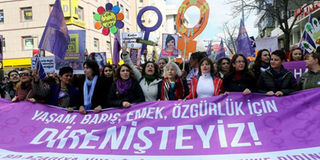Respect health rights of women and girls

Turkish women shout slogans as they carry a banner which translates as " We resist for life, peace, labour and freedom." during a demonstration marking International Women's Day in Ankara on March 6, 2016. PHOTO | AFP
What you need to know:
- In 2012, nearly 120,000 Kenyan women received care for complications from unsafe abortions.
- Over 70 per cent of women seeking post-abortion care in Kenya were not using contraception prior to becoming pregnant.
- One of the best ways to reduce unsafe abortions is to provide girls and women with access to comprehensive sex education
“As a shy, reserved young boy, I couldn’t speak about sex. I learned from a very early age that it was taboo to talk about it.
“Even so, my peers talked about sex, shared their thoughts and sometimes experiences.
“Looking back, I really did not know anything about sexual health, and I realise now that many of the stories that my peers were sharing were based on myths, misconceptions, and sometimes outright misinformation that threaten the health of young people, particularly girls and young women.” — Mark Gachagua.
This story, multiplied hundreds of millions of times, is the reason we need to invest more in the health, rights, and wellbeing of girls and women throughout Kenya and the world.
In Kenya, inadequate sex education is just one of the many factors that contribute to a high rate of maternal mortality. In 2012, nearly 120,000 Kenyan women received care for complications from unsafe abortions. The vast majority of these resulted from unwanted pregnancies. Over 70 per cent of women seeking post-abortion care in Kenya were not using contraception prior to becoming pregnant.
We know that one of the best ways to reduce unsafe abortions is to provide girls and women with access to comprehensive sex education and contraceptives. Yet, globally, more than 225 million women who want to avoid pregnancy are not using modern contraceptives.
FILL GLOBAL GAPS
If we filled these global gaps in sexual and reproductive health services, education and rights — and provided women with the full range of pregnancy care they are entitled to — we could reduce unintended pregnancy and unsafe abortions.
We also know that when girls and women can choose when and whether to have children, they are more likely to reach their full potential — and so are their families, communities and economies. For these reasons we owe it to our mothers, sisters, and daughters, as well as our families and communities, to do more and do better.
We must approach health and development through a gender lens. We must look for solutions from every region, sector, and generation — from providing comprehensive sex education in secondary schools to advocating the decriminalisation of abortion services.
These solutions and many others will be explored at the Women Deliver 2016 Conference scheduled to take place in Copenhagen in May, which will discuss how to deliver on promises to girls and women.
A good 20 per cent of those who will attend the conference will be young people — and for a good reason: young people are not just our tomorrow; they are the leaders of today and must be given opportunities to drive change in their communities.
With the endorsement of the recently launched Sustainable Development Goals, which aim to end poverty, protect the planet, and ensure prosperity for all by 2030, we can and must ensure that the global push to end poverty, fight inequality, and tackle climate change starts with every girl and woman, no matter where she lives, no matter her age. As they say, it is time to translate the talk into walk and turn speech lines into budget lines.
This International Women’s Day, let us recognise the powerful solutions every young person and generation has to offer. Let us work smarter for girls and women everywhere.
Ms Iversen is CEO, Women Deliver. Twitter: @Katja_Iversen. Mr Gachagua is young leader, Women Deliver, and coordinator, World Starts with Me Youth Advocacy Network.




